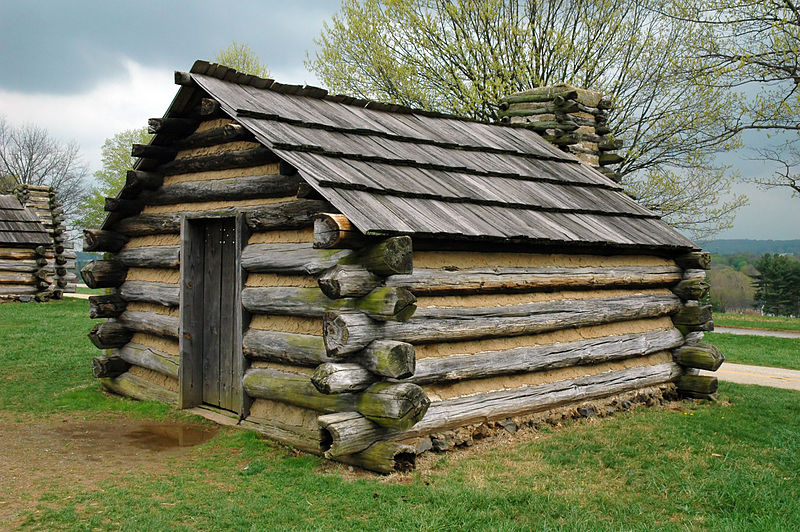History of the Log Cabin in America
Ancient Beginnings
The exact time and place of the origin of log construction is most likely lost forever. It is generally assumed to have begun in the Bronze Age (c. 3,500 BCE) somewhere in Northern Europe. Wherever its true beginnings lay, the building of log homes spread to anywhere that logs were readily available, and harsh winters necessitated sturdy, warm dwellings.
The first historical reference we have to log construction comes from the Roman architect Marcus Vitruvius Pollio in the first century BCE. He noted a particular style of dwelling in modern day Romania that was built by laying logs horizontally and filling the gaps in with mud and wood chips.
By the time the New World was discovered, the log cabin had a long history and many established styles and building techniques. Scandinavian peoples, in particular Swedes and Finns, were noted for their skillfully built structures. According to log cabin historian and author C. A. Weslager:
The Finns were accomplished in building several forms of log housing, having different methods of corner timbering, and they utilized both round and hewn logs. Their log building had undergone an evolutionary process from the crude “pirtti”…a small gabled-roof cabin of round logs with an opening in the roof to vent smoke, to more sophisticated squared logs with interlocking double-notch joints, the timber extending beyond the corners. Log saunas or bathhouses of this type are still found in rural Finland.
By stacking tree trunks one on top of another and overlapping the logs at the corners, people made the “log cabin”. They developed interlocking corners by notching the logs at the ends, resulting in strong structures that were easier to make weather-tight by inserting moss or other soft material into the joints. As the original coniferous forest extended over the coldest parts of the world, there was a prime need to keep these houses warm. The insulating properties of the solid wood were a great advantage over a timber frame construction covered with animal skins, felt, boards or shingles. Over the decades, increasingly complex joints were developed to ensure more weather tight joints between the logs, but the profiles were still largely based on the round log.
Coming to America
It was these same Swedes and Finns who are thought to have first brought log cabin construction to the New World. The short-lived colony of New Sweden, in modern day Delaware, was founded in 1638. Its settlers brought with them their knowledge of log construction, and they found materials to build their settlements in the forests of the Delaware and Brandywine River valleys.
Though New Sweden was absorbed by the Dutch colony of New Netherland in 1655 (as a result of the Second Northern War in Europe), their log construction techniques not only remained, but spread quickly. Seeing its many advantages, the Dutch (and eventually immigrants to the New World from all over Europe) adopted the log cabin as the preferred type of dwelling anywhere near forested areas. The log cabin’s status as a symbol of the American frontier was cemented.
A Symbol of the Frontier
Wherever people pushed westward looking for land and opportunity they brought the log home with them. Log buildings were fairly easy to construct and speedy to erect – a lone man could have one up in only a couple of weeks. Proper site selection was important; good drainage and proper sunlight were both key, as was a solid vantage point from which to manage the property. If a homesteader had any luck, they would be able to find enough straight trees that they would not need to be hewn to fit together well.
Styles varied from region to region based on a large number of factors, but most cabins had only a single approximately square room, averaging twelve to sixteen feet long, with a single door and no windows. A fireplace would be put at one end to provide heat and a place to cook. A man with a family might put up a quick small cabin, then have time to build a larger dwelling if they desired, but for many a simple cabin was more than sufficient.
Back From the Brink
In time, as the frontier slowly disappeared and the urbanization of America began, the death of the log cabin seemed imminent. Two unlikely sources, however, contributed to keeping the log cabin tradition alive.
The first of these was the late nineteenth century rise of Great Camps, grandiose and luxurious getaways built by wealthy families in the Adirondacks of upstate New York. There they could escape the summer heat or the general hustle and bustle of the city for time in the wilderness. Suddenly, the log home was fashionable.
The second surprise source of a log cabin revival was the Great Depression. During much of the 1930s, the Civilian Conservation Corp, in tandem with the National Park Service and U.S. Forest Service, build thousands of log structures across the country in protected natural areas. When National Park attendance later boomed, so too did people’s exposure to, and appreciation of, log cabin-style construction.
A Modern Take
Today, log home construction is still popular, especially in rural (and sometimes even in suburban) areas. We have come along way from the single room squares of days past. Improved materials and construction techniques means that a log home today can be simple and rustic or as luxurious as your imagination can think up. For many, log homes represent all a family might want; a sturdy shelter from the elements and a simple, self-sufficient lifestyle.



Hotels in Melbournelodge specialslate lodge hotel offers.
This site was… how do I say it? Relevant!! Finally I have found something that helped me.
Thanks a lot!
Wholesale Log Homes
You’re welcome. Please let us know when we may be of service.
The team at http://www.wholesaleloghomes.com